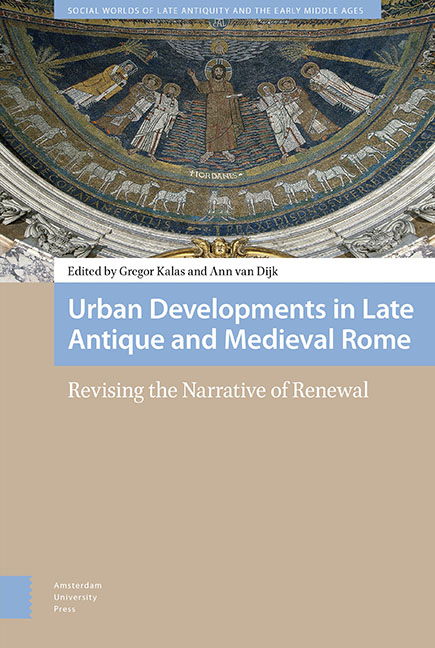Book contents
- Frontmatter
- Contents
- Preface and Acknowledgments
- List of Abbreviations
- 1 Introduction: Revising the Narrative of Renewal for Late Antique and Medieval Rome
- 2 Rome at War: The Effects of Crisis on Church and Community in Late Antiquity
- 3 Portraits of Poets and the Lecture Halls in the Forum of Trajan : Masking Cultural Tensions in Late Antique Rome
- 4 Rolling Out the Red Carpet, Roman-Style : The Arrival at Rome From Constantine to Charlemagne
- 5 (Re-)Founding Christian Rome: The Honorian Project of the Early Seventh Century
- 6 After Antiquity: Renewing the Past or Celebrating the Present? Early Medieval Apse Mosaics in Rome
- 7 The Re-Invention of Rome in the Early Middle Ages
- 8 Rewriting the Renouveau
- 9 Renewal, Heritage, and Exchange in Eleventh-Century Roman Chant Traditions
- 10 Reforming Readers, Reforming Texts: The Making of Discursive Community in Gregorian Rome
- Manuscripts Cited
- Index
6 - After Antiquity: Renewing the Past or Celebrating the Present? Early Medieval Apse Mosaics in Rome
Published online by Cambridge University Press: 18 June 2021
- Frontmatter
- Contents
- Preface and Acknowledgments
- List of Abbreviations
- 1 Introduction: Revising the Narrative of Renewal for Late Antique and Medieval Rome
- 2 Rome at War: The Effects of Crisis on Church and Community in Late Antiquity
- 3 Portraits of Poets and the Lecture Halls in the Forum of Trajan : Masking Cultural Tensions in Late Antique Rome
- 4 Rolling Out the Red Carpet, Roman-Style : The Arrival at Rome From Constantine to Charlemagne
- 5 (Re-)Founding Christian Rome: The Honorian Project of the Early Seventh Century
- 6 After Antiquity: Renewing the Past or Celebrating the Present? Early Medieval Apse Mosaics in Rome
- 7 The Re-Invention of Rome in the Early Middle Ages
- 8 Rewriting the Renouveau
- 9 Renewal, Heritage, and Exchange in Eleventh-Century Roman Chant Traditions
- 10 Reforming Readers, Reforming Texts: The Making of Discursive Community in Gregorian Rome
- Manuscripts Cited
- Index
Summary
Abstract
This chapter looks beyond the concept of ‘renewal’, which still dominates our view of the medieval art and architecture of Rome. An alternative approach examines selected monuments from a synchronic view in which linear time transforms into what I would like to define as a ‘continuous present’. This amplifies our view of how medieval images worked, not only in Rome, but also more broadly. Perceived as special and unique to Rome, the current narrative ends up isolating the city and its monuments within a sort of closed self-contained cyclical system with little relevance to what is going on fuori le mura. Discussing a number of the city's early medieval apse mosaics, I argue that the narrative is ready for revision.
Keywords: apse mosaics (Rome), relics, inscriptions in churches, temporality, communio sanctorum
The art and architecture of the medieval city of Rome is typically presented in art historical scholarship as periodically renewing itself across some thousand years – from the emergence of the first Christian basilicas in the fourth century, to the fourteenth century when the papacy left the Urbs (1309) to reside in the French city of Avignon, returning in 1376. The source for these revivals is, of course, the city's imperial past as caput mundi – pagan or Christian – as reflected in the splendor and exalted artistic quality of its monuments. Perhaps no other study on the topic has proved more influential in promoting this narrative than Richard Krautheimer's book Rome: Profile of a City, 312–1308, first published in 1980 by Princeton University Press. The goal of this superbly written historical survey, as stated by its author, is: ‘to outline a history of Rome during a thousand years through, rather than of, her monuments.’ What transpires from his presentation of this millennial trajectory, as told by the monuments themselves, is the ebb and flow of the reception of imperial Rome in the city's visual and architectural culture. A classical ‘revival’ of the fifth century followed by a ‘renewal and renascence’ of the Carolingian period and another ‘rebirth’ and ‘renewal’ from the late eleventh through the thirteenth century are thus seen to alternate with periods of urban devastation, ‘eastern’ political dominance or utter moral, social, and economic decline.
- Type
- Chapter
- Information
- Urban Developments in Late Antique and Medieval RomeRevising the Narrative of Renewal, pp. 177 - 204Publisher: Amsterdam University PressPrint publication year: 2021

